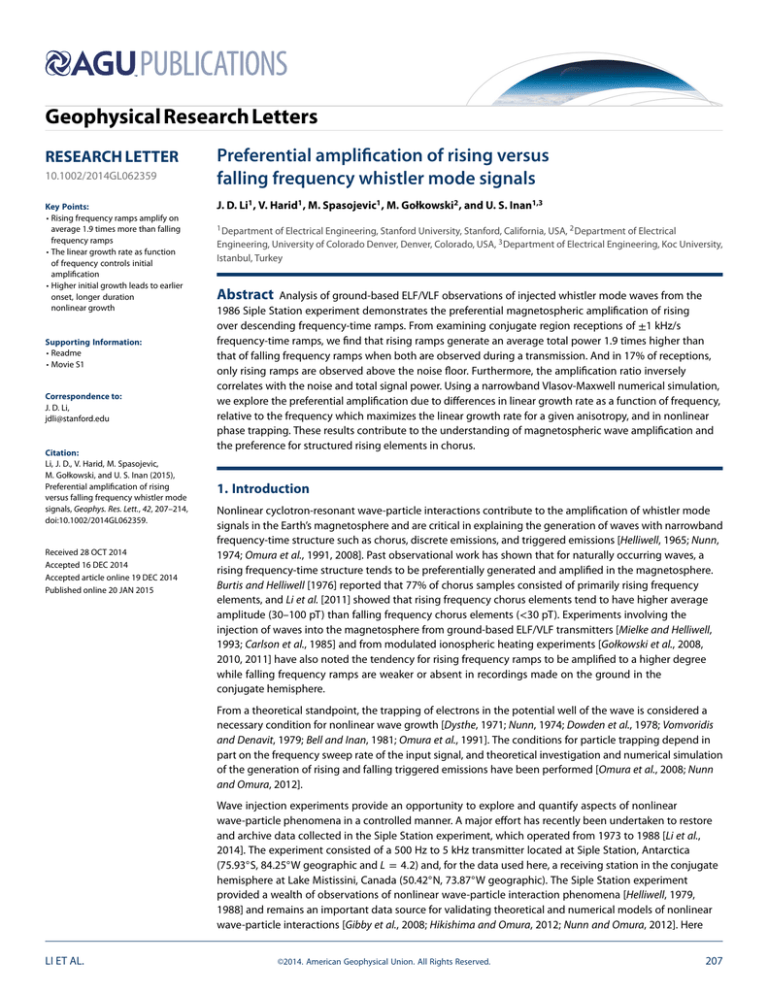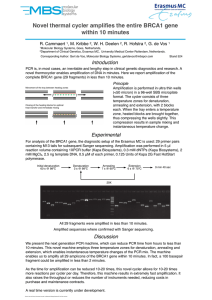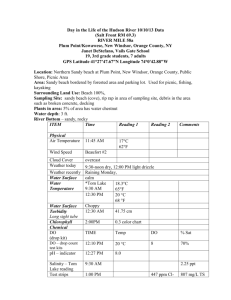
Geophysical Research Letters
RESEARCH LETTER
10.1002/2014GL062359
Key Points:
• Rising frequency ramps amplify on
average 1.9 times more than falling
frequency ramps
• The linear growth rate as function
of frequency controls initial
amplification
• Higher initial growth leads to earlier
onset, longer duration
nonlinear growth
Supporting Information:
• Readme
• Movie S1
Correspondence to:
J. D. Li,
jdli@stanford.edu
Citation:
Li, J. D., V. Harid, M. Spasojevic,
M. Gołkowski, and U. S. Inan (2015),
Preferential amplification of rising
versus falling frequency whistler mode
signals, Geophys. Res. Lett., 42, 207–214,
doi:10.1002/2014GL062359.
Received 28 OCT 2014
Accepted 16 DEC 2014
Accepted article online 19 DEC 2014
Published online 20 JAN 2015
Preferential amplification of rising versus
falling frequency whistler mode signals
J. D. Li1 , V. Harid1 , M. Spasojevic1 , M. Gołkowski2 , and U. S. Inan1,3
1 Department of Electrical Engineering, Stanford University, Stanford, California, USA, 2 Department of Electrical
Engineering, University of Colorado Denver, Denver, Colorado, USA, 3 Department of Electrical Engineering, Koc University,
Istanbul, Turkey
Abstract
Analysis of ground-based ELF/VLF observations of injected whistler mode waves from the
1986 Siple Station experiment demonstrates the preferential magnetospheric amplification of rising
over descending frequency-time ramps. From examining conjugate region receptions of ±1 kHz/s
frequency-time ramps, we find that rising ramps generate an average total power 1.9 times higher than
that of falling frequency ramps when both are observed during a transmission. And in 17% of receptions,
only rising ramps are observed above the noise floor. Furthermore, the amplification ratio inversely
correlates with the noise and total signal power. Using a narrowband Vlasov-Maxwell numerical simulation,
we explore the preferential amplification due to differences in linear growth rate as a function of frequency,
relative to the frequency which maximizes the linear growth rate for a given anisotropy, and in nonlinear
phase trapping. These results contribute to the understanding of magnetospheric wave amplification and
the preference for structured rising elements in chorus.
1. Introduction
Nonlinear cyclotron-resonant wave-particle interactions contribute to the amplification of whistler mode
signals in the Earth’s magnetosphere and are critical in explaining the generation of waves with narrowband
frequency-time structure such as chorus, discrete emissions, and triggered emissions [Helliwell, 1965; Nunn,
1974; Omura et al., 1991, 2008]. Past observational work has shown that for naturally occurring waves, a
rising frequency-time structure tends to be preferentially generated and amplified in the magnetosphere.
Burtis and Helliwell [1976] reported that 77% of chorus samples consisted of primarily rising frequency
elements, and Li et al. [2011] showed that rising frequency chorus elements tend to have higher average
amplitude (30–100 pT) than falling frequency chorus elements (<30 pT). Experiments involving the
injection of waves into the magnetosphere from ground-based ELF/VLF transmitters [Mielke and Helliwell,
1993; Carlson et al., 1985] and from modulated ionospheric heating experiments [Gołkowski et al., 2008,
2010, 2011] have also noted the tendency for rising frequency ramps to be amplified to a higher degree
while falling frequency ramps are weaker or absent in recordings made on the ground in the
conjugate hemisphere.
From a theoretical standpoint, the trapping of electrons in the potential well of the wave is considered a
necessary condition for nonlinear wave growth [Dysthe, 1971; Nunn, 1974; Dowden et al., 1978; Vomvoridis
and Denavit, 1979; Bell and Inan, 1981; Omura et al., 1991]. The conditions for particle trapping depend in
part on the frequency sweep rate of the input signal, and theoretical investigation and numerical simulation
of the generation of rising and falling triggered emissions have been performed [Omura et al., 2008; Nunn
and Omura, 2012].
Wave injection experiments provide an opportunity to explore and quantify aspects of nonlinear
wave-particle phenomena in a controlled manner. A major effort has recently been undertaken to restore
and archive data collected in the Siple Station experiment, which operated from 1973 to 1988 [Li et al.,
2014]. The experiment consisted of a 500 Hz to 5 kHz transmitter located at Siple Station, Antarctica
(75.93◦ S, 84.25◦ W geographic and L = 4.2) and, for the data used here, a receiving station in the conjugate
hemisphere at Lake Mistissini, Canada (50.42◦ N, 73.87◦ W geographic). The Siple Station experiment
provided a wealth of observations of nonlinear wave-particle interaction phenomena [Helliwell, 1979,
1988] and remains an important data source for validating theoretical and numerical models of nonlinear
wave-particle interactions [Gibby et al., 2008; Hikishima and Omura, 2012; Nunn and Omura, 2012]. Here
LI ET AL.
©2014. American Geophysical Union. All Rights Reserved.
207
Geophysical Research Letters
10.1002/2014GL062359
fset + offset (Hz)
(a) STACO Transmission Format
Riser 1
500
Riser 2
dB
Faller 1
55
Faller 2
0
50
−500
5
0
10
15
20
25
30
35
40
45
Time(s)
Frequency (kHz)
(b) LM 9 Oct 1986 12:21:00 UT
45
4
3
2
40
Frequency (kHz)
(c) LM 14 Aug 1986 11:49:00 UT
Frequency (kHz)
fset=3000 Hz, r=2
fset=4020 Hz, r=1
5
4
35
3
(d) LM 21 Nov 1986 15:47:00 UT
4
fset=1680 Hz, r=
30
3
2
1
25
5
10
15
20
25
30
35
40
45
Time after transmission (s)
Figure 1. (a) Illustration of the STACO format transmitted by Siple and conjugate receptions with riser to faller
amplification ratios of (b) r = 2, (c) r = 1, and (d) r = ∞.
we analyze a database of transmissions consisting of a sequence of rising and falling frequency ramps
(± 1 kHz/s) and develop a metric to quantify the relative amplification of each transmission. We
subsequently use a recently developed first-order, narrowband Vlasov-Maxwell solver to simulate the
growth of rising and falling frequency ramps. We investigate differences in amplification by examining
the differences in the linear growth rate as a function of frequency as well as the conditions for particle
trapping and nonlinear growth.
2. Statistical Observations From 1986
The staircase coherence format, abbreviated STACO, transmitted by Siple Station from July to December
of 1986 is illustrated in Figure 1a and is composed of two identical sets of rising, 1 kHz/s ramp elements
(Riser 1 and Riser 2), followed by two identical sets of falling, −1 kHz/s ramp elements (Faller 1 and Faller
2). Each ramp set is composed of five elements that are approximations to an ideal frequency ramp using
1 ms, 10 ms, 25 ms, 50 ms, and 100 ms long tones with each ramp being 1 s in total duration. The entire
transmission is centered on an operator-selected tuning frequency, fset , which ranged from 1680 Hz to
4020 Hz. Data from the conjugate receiving station is available for 170 transmissions of the STACO format,
and 63 receptions were detected for a 37% reception rate. Of those detected, 60 were received with
sufficient signal-to-noise ratio for further analysis. The format was originally intended for studying the
required time-frequency spacing to approximate a continuous frequency ramp [Mielke and Helliwell, 1993].
The goal of the current study is to compare the total magnetospheric amplification, which includes both
the amplification of the transmission and the generation of triggered free-running emissions, resulting
from the injection of rising versus falling frequency ramps. We develop a metric to calculate the total signal
power generated from each set of ramp elements, and we make comparisons between rising and falling
sets only within a given transmission in order to eliminate variations due to changes in background
LI ET AL.
©2014. American Geophysical Union. All Rights Reserved.
208
Geophysical Research Letters
10.1002/2014GL062359
conditions. To calculate this metric, we manually identify a set of rising or falling ramps, preprocess to reduce
interference from lightning-generated sferics using a sparse separation technique [Strauss, 2013, section 2].
Then, we apply a 75,000-point fast Fourier transform with proper scaling for the signal duration and filter
the result using a 1000-point median filter to further remove impulsive noise in the frequency domain, such
as power line harmonics and single-frequency fluctuations in the background noise. We integrate over a
3 kHz window centered on fset and identify this number as the uncalibrated power metric for the signal
using Parseval’s theorem. We also apply this same methodology to a manually selected segment of data
from several seconds prior to or following the ramp set to characterize the local background noise around
the time of the ramp reception. This noise power is then subtracted from the signal power metric to obtain
a single number for the amplification metric. The amplification ratio (r) is then the ratio of the amplification
metric for different sets of ramps within a transmission, such as rising to falling or Rising 1 to Rising 2.
Figures 1b–1d show examples of receptions of the STACO format for three different amplification ratios.
Figures 1b–1d are aligned in time and are shifted 3 s from Figure 1a to account for propagation delay. The
first example (Figure 1b) shows a case where the rising to falling amplification ratio is about 2 and exhibits
stronger amplification of the transmitted rising signals, triggered emissions (downward hooks at the top of
the rising ramps), and visible multipath effects. The Siple transmissions are believed to reach the conjugate
hemisphere primarily in a ducted propagation mode [Carpenter and Sulic, 1988], and multipath refers to
the phenomenon where the transmission propagates in multiple magnetospheric ducts simultaneously.
Multipath effects can be seen on the spectrograms in Figures 1b–1d as additional receptions within a 0.5 s
window. In Figure 1c, the rising to falling amplification ratio is near unity, with both risers and fallers
appearing similar in intensity and embedded in a band of hiss. Finally, Figure 1d is an example where the
fallers are not detected (deemed r = ∞) while some significant portion of the risers are detected and
generate rising tone-triggered emissions that extend > 1 kHz above the transmitted ramp.
The distribution of amplification ratios for all received transmissions of the STACO format is shown in
Figure 2. The histogram in Figure 2a presents the amplification ratio for Riser 1 to Riser 2 sets in order to
evaluate any possible difference in amplification due to temporal effects. The median value of r is 1.06 and
61% of cases have values of r between 0.75 and 1.25. The histogram in Figure 2b shows the distribution of
the amplification ratio for rising to falling ramps. We note that the bin with highest occurrence (n = 10) is the
infinite ratio bin, that is, the falling ramps are not received at all. The median value of the ratio, not including
the infinite cases, is 1.93, and 12 cases (20%) have a r value less than 1, that is, fallers are amplified more than
risers. Of those 12 cases, 5 cases have r > 0.8, 4 cases have 0.8 > r > 0.5, and 3 cases have a 0.5 > r > 0.3.
The results from Figure 2a, that subsequent ramps have an amplification ratio near 1, suggest that the
differences in the rising to falling amplification are unlikely to be due to temporal effects within a given
transmission. Figure 2c shows a scatterplot of the noise power versus the rising to falling amplification ratio,
where the dividing r = 1 line separates the two regions of differing behavior. As we have an insufficient
number of cases where r < 1, we examine cases only where the risers are amplified more than fallers and
the fallers are received (that is, 1 < r < ∞) and find that as the noise power increases, the amplification ratio
decreases. The correlation coefficient between noise power and amplification ratio in that range of r is −0.46
(p < 0.01). Li et al. [2014] reported that the primary contribution to the increase in noise power for Siple
receptions is the occurrence of natural emissions such as hiss, as seen in Figure 1c, and as such, intervals
of higher noise power likely indicate when the conditions for linear growth are enhanced. As applied to
Figure 2c, lower noise power suggests lower linear growth rates which are then associated with higher
amplification ratios. Figure 2d shows a scatterplot of the total power of the rising ramps versus the rising to
falling amplification ratio with a similar trend of the rising power metric increasing as the amplification ratio
decreases. We also examined the relationship between the amplification ratio and the fset frequency, the
Kp index at the time of transmission, and the local time of transmission and found no correlation.
3. Theory and Modeling
Modeling the propagation and growth of whistler mode waves interacting with energetic radiation
belt electrons requires solving the Vlasov-Maxwell system of equations. The evolution of the electron
distribution function is governed by the Vlasov equation while the wave fields are generated according
to Maxwell’s equations. Under the assumption of parallel propagating signals, which ducted Siple signals
are considered to be, the interaction between waves and particles is dominated by cyclotron resonance.
For small amplitude injected waves, the solution to the Vlasov-Maxwell system according to linear theory
LI ET AL.
©2014. American Geophysical Union. All Rights Reserved.
209
Geophysical Research Letters
10.1002/2014GL062359
(a) Rising 1 to Rising 2 Ratio Histogram
(b) Rising to Falling Ratio Histogram
30
15
n = 56 cases
median of ratio = 1.06
n = 60 cases
median of ratio = 1.93
10
Count
Count
20
5
10
0
0.1
1
0
0.1
10
Amplification Ratio (log−scale)
80
<2.5
~3
~3.5
~4
(kHz)
Rising Metric (dB)
Noise Power (dB)
30
20
10
0
0.1
10
(d) Rising Metric vs. Rising to Falling Ratio
(c) Noise Power vs. Rising to Falling Ratio
50
40
1
Amplification Ratio (log−scale)
1
70
60
50
40
30
0.1
10
Amplification Ratio (log−scale)
1
10
Amplification Ratio (log−scale)
Figure 2. Results from the statistical analysis of the STACO format. The histograms show (a) the amplification ratio
between the sequential rising sets, Riser 1 and Riser 2, and (b) the amplification ratio between rising and falling sets with
the amplification ratios on a log scale. The scatterplots show the log-scale riser to faller amplification ratio as functions
of (c) the noise power metric (color coded by the value of fset ) and (d) the riser amplification metric.
predicts exponential wave growth if the electron distribution is sufficiently anisotropic [Kennel and Petschek,
1966]. Although the linear growth rate is a function of frequency, linear growth of rising and falling
frequency ramps sweeping over the same frequency range will result in the same net integrated
amplification, and thus, variations in the linear growth rate with frequency cannot explain the preferential
amplification of rising ramps observed in the data. However, after undergoing linear growth, the wave
amplitudes can become large enough to trap resonant electrons in the wave potential well, and the
formation of this trap is believed to play a crucial role in nonlinear wave growth [Nunn, 1974; Dowden et al.,
b1978; Vomvoridis and Denavit, 1979; Bell and Inan, 1981; Omura et al., 1991]. The conditions for particle
trapping can be summarized by a single collective inhomogeneity parameter, S, [Omura et al., 1991] defined
as follows:
]
[(
)
kv⊥2 𝜕𝜔c 2𝜔 + 𝜔c d𝜔
1
−
S=
(1)
3VR −
𝜔c
𝜕z
𝜔
dt
2𝜔2t
with the quantities 𝜔c , 𝜔, and k representing the electron gyrofrequency, wave frequency, and wave
number, respectively. VR is the resonance velocity, and v⊥ is the component of the particle velocity
perpendicular to the geomagnetic field, which is oriented in the z direction. The quantity 𝜔t is the trapping
frequency defined as follows:
(
𝜔t =
qv⊥ kBw
me
)1
2
(2)
where Bw is the wave magnetic field, q is the magnitude of the electron charge, and me is the electron mass.
When S has a magnitude less than 1, particle trapping and consequently nonlinear wave
can occur.
( growth
)
𝜕𝜔
As shown in equation (1), S depends on the inhomogeneity of the geomagnetic field 𝜕zc as well as on the
frequency sweep rate of the wave ( d𝜔
). For simplicity, we first consider the hypothetical case of a constant
dt
amplitude wave. The center of the interaction region is defined at S = 0, and the extent of the interaction
region is defined where |S| < 1. For a monochromatic wave, ‖S(z)‖ is symmetric around the equator, and
thus, the nonlinear interaction region is also symmetric around the equator. For a rising frequency ramp,
LI ET AL.
©2014. American Geophysical Union. All Rights Reserved.
210
Geophysical Research Letters
10.1002/2014GL062359
𝜕w
𝜕t
is a positive constant, and S(z) thus resembles the monochromatic profile except that it is shifted
upstream to latitudes toward the transmitter. Likewise, the reverse scenario holds true for a falling frequency
ramp, and the nonlinear interaction region shifts downstream toward the receiver. For the case of a constant
amplitude wave, the spatial shift in the interaction region is approximately symmetric around the equator
for rising and falling tones. The inclusion of wave amplification adds to the complexity as 𝜔t depends on
the wave amplitude, and the wave amplitude will be growing as a function of position along the magnetic
field line, which then changes the value of S; this is an important aspect that contributes to the difference in
amplification of rising compared to falling ramps.
3.1. Numerical Model
Modeling nonlinear amplification of coherent waves is analytically intractable and must be approached
using numerical techniques. The Vlasov equation in canonical coordinates is shown in equation (3), where
dx
the terms dti are governed by the single-particle equations of motion, the Lorentz force.
𝜕f ∑ dxi 𝜕f
+
=0
𝜕t i=1 dt 𝜕xi
n
(3)
In this study, we simulate the amplification of rising and falling frequency ramps using a recently developed
narrowband Vlasov solver [Harid et al., 2014]. The solver discretizes the Vlasov equation on a uniform
phase-space grid and then integrates in time using a first-order finite difference linear upwind scheme.
The model is well suited for simulating the growth of coherent waves in the large amplitude regime where
particle phase-trapping dominates.
Since the waves in this simulation are coherent, the Vlasov equation can be coupled to the narrowband
wave equations shown in equations (4) and (5), which also account for the background cold plasma
[Nunn, 1974].
𝜇 0 vg
𝜕Bw
𝜕B
− vg w = −
J
𝜕t
𝜕z
2 E
(4)
𝜇 0 v g JB
𝜕𝜙w
𝜕𝜙
− vg w = −
𝜕t
𝜕z
2 Bw
(5)
The quantities Bw and 𝜙w are the wave amplitude and phase of the modulating wave packet propagating in
the −z direction at the group velocity, vg . JE and JB are components of the resonant current in the direction
of the wave electric and magnetic fields, respectively. The narrowband wave equations are integrated in
time with the same finite difference scheme used for the Vlasov equation.
To simulate the Siple transmissions, we use a centered dipole geomagnetic field model at L = 4 and a cold
−3
plasma density
( of(250) cm ). The hot plasma distribution function is a bi-Maxwellian with a temperature
T⊥
anisotropy A = T − 1 of 1.16 and a hot electron density (nh ) of 0.25 cm−3 . The simulation domain
∥
extends out ±5000 km around the equator, chosen based on the minimum trapping amplitude threshold
parameterized by S and for consistency with past work [Nunn, 1974; Gibby et al., 2008]. Pulses that rise or fall
in frequency are injected into the simulation space by enforcing a chirped phase at the input with an initial
amplitude of 0.1 pT. The input pulses are 0.5 s in duration, and the rising and falling ramps have equal
though opposite sweep rates, cover the same 500 Hz range of frequencies, and have the same center
frequency. The instantaneous frequency profile for the rising ramps is given by frise (t) = (fset − 250) + 1000t
and for the falling ramps by ffall (t) = (fset + 250) − 1000t, where fset is the center frequency of the ramp. The
linear growth spectrum for the simulation parameters is shown in Figure 3a, and a family of linear growth
rate curves for varying anisotropies is shown in Figure 3b. In Figure 3a, the frequency at which the linear
growth rate is maximized (fm ) is 2450 Hz, and the center frequencies for the simulation are chosen such that
two frequencies are below fm (1000 Hz and 1500 Hz), and the other two are above fm (3480 Hz and 4500 Hz).
Linear growth alone cannot explain the difference between rising and falling ramps; however, all signals
first undergo linear growth before crossing the nonlinear threshold. Therefore, rising ramps with a center
frequency above the maximum linear growth rate frequency will at first grow faster than falling ramps as the
starting frequency is closer to fm and subsequently reach the nonlinear threshold sooner. We thus expect
LI ET AL.
©2014. American Geophysical Union. All Rights Reserved.
211
Geophysical Research Letters
10.1002/2014GL062359
Figure 3. (a) The linear growth rate curve as a function of wave frequency for A = 1.16 and nh = 0.25 cm−3 with four
points indicating the center frequency for the simulation in the corresponding panel and (b) as a family of such curves
for a range of anisotropies. The time series plots show the simulated amplitude at the end of the interaction region
(z = 5000 km) for (c) fset = 1000 Hz, (d) fset = 1500 Hz, (e) fset = 3480 Hz, and (f ) fset = 4500 Hz for risers (blue) and fallers
(red). Additionally, the spatial amplitude profile over the interaction region is shown at (g) t = 0.44s and at (h) t = 0.61 s
for risers (blue) and fallers (red), with the minimum trapping amplitude for a monochromatic wave with 70◦ pitch
angle (black).
rising ramps to amplify more in these cases and falling ramps to amplify more in the cases where the center
frequency is below the maximum linear growth rate frequency.
The received wave amplitudes for the fully nonlinear simulations are shown in Figures 3c–3f, plotted as
a function of time at the output of the simulation space (z = 5000 km). For the two cases where the
center frequency is below fm , Figures 3c and 3d, the falling ramps grow more than the rising ramps. The
corresponding amplification ratios (riser to faller) are 0.554 and 0.556 for the 1000 Hz and 1500 Hz cases,
respectively. Figures 3e and 3f, with center frequencies of 3480 Hz and 4500 Hz, correspond to the cases
where the rising ramp grows faster at first due to the higher initial linear growth rate and thus reaches the
trapping threshold sooner. The corresponding amplification ratios are 2.27 for fset = 3480 Hz and 4181
for fset = 4500 Hz. In fact, for the 4500 Hz case (Figure 3f ), the falling ramp does not reach the trapping
threshold and does not undergo any nonlinear growth and subsequently gives a far lower output amplitude
than the rising ramp and thus a very large amplification ratio, matching well with the infinity ratio cases.
The fact that Siple observations generally show a higher degree of growth for rising ramps suggests that
the transmitted signals are more likely to be above fm . Further, as seen in Figure 3b, when the electron
temperature anisotropy decreases, the value of fm decreases. Thus, lower anisotropies will favor the growth
LI ET AL.
©2014. American Geophysical Union. All Rights Reserved.
212
Geophysical Research Letters
10.1002/2014GL062359
of risers, as more of the spectrum is above fm . This is consistent with the observational finding in Figure 2c
showing that lower noise power (which is associated with less natural emissions and presumably a lower
linear growth rate) favors higher amplification ratios (better amplification of risers). As A decreases, risers are
favored, but the total growth of signals is expected to be lower, and this trend is seen in Figure 2d where
higher amplification of risers over fallers is associated with lower total power in the risers.
Spatial amplitude profiles from the simulation shown in Figure 3e with fset = 3480 Hz are shown at two
different time steps in the simulation in Figures 3g and 3h, with an animation of all of the full simulations in
the supplementary materials. The dashed curve represents the minimum amplitude for particle trapping for
a monochromatic tone at fset . At t = 0.44 s in Figure 3g, in the region upstream of the equator (z < 0), the
waves are below the minimum trapping amplitude and grow according to linear theory. The linear growth
rate, which is a function of the wave frequency, is initially higher for the rising tone as it starts at a lower
frequency. This difference in initial linear growth rates ensures that the rising tone crosses the minimum
trapping amplitude sooner than the falling tone and consequently undergoes nonlinear growth sooner
as well.
At a later time (t = 0.61 s), shown in Figure 3h, the waves have propagated further through the simulation
space. The wave amplitude of the falling ramp is still lower than the rising ramp; however, the falling ramp
has grown in time such that the wave crosses the minimum trapping amplitude. This occurs due to the
increase in linear growth rate resulting from the decrease in the falling ramp frequency and partially from
the accompanying shift of the nonlinear interaction region downstream. Conversely, the rising ramp begins
to damp slightly near (z = 0) because the linear growth rate has decreased due to the increased frequency;
however, since the riser crossed the trapping threshold earlier in time, the change in the linear growth rate
does not play as much of a role. The net effect is that the rising ramp undergoes more amplification than the
falling frequency ramp.
4. Conclusions
Historical observations of Siple Station transmissions [Mielke and Helliwell, 1993; Carlson et al., 1985], along
with more recent cases from HAARP wave injection experiments [Gołkowski et al., 2008, 2011] and satellite
recordings of discrete chorus elements [Burtis and Helliwell, 1976; Li et al., 2011], indicate a natural
preference for the amplification of rising frequency signals over falling frequency signals. Furthermore, the
importance of the time and location of the transition from linear to nonlinear growth was postulated from
wave injection observations made by Gołkowski et al. [2010].
Here, for the first time, we quantify the amplification of rising and falling frequency ramps injected into the
magnetosphere from Siple Station and use a narrowband Vlasov-Maxwell simulation to interpret the results.
Simulations show that the net amplification of frequency ramps depends on both the linear growth rate
and the duration of nonlinear growth. When the center frequency of the ramp is above fm , the frequency at
which the linear growth rate is maximized, rising frequency ramps will undergo more initial linear growth.
Conversely, falling frequency ramps will undergo more initial growth when the center frequency is below
fm . Further, for rising frequency ramps the nonlinear interaction region is shifted upstream (to latitudes
below the equator for a Southern Hemisphere transmitter), and thus, rising ramps can undergo nonlinear
growth earlier and for a longer duration owing to the feedback effect of wave amplitude on the conditions
for nonlinear growth (such as expressed in the S parameter). These effects combine to result in a net
preferential amplification of rising frequency ramps. In the Siple receptions, we find that rising frequency
ramps generate a total power that is on average 1.9 times higher than that of falling frequency ramps when
both are received within a given transmission. Also, in 17% of receptions, only the rising frequency ramps are
observed, and the falling ramps are below the detectable signal level. This may occur when the falling ramps
do not reach the threshold for nonlinear growth such as when the ramp center frequency is well above fm as
in Figure 3f. A lower value of hot electron temperature anisotropy will move fm to lower frequency, further
favoring the growth of rising ramps. This is supported observationally by the inverse correlation between
the amplification ratio and both the observed noise power and the total signal power metric. Finally, in
20% of the receptions, falling ramps are amplified more than rising ramps, and simulations show that this
may occur when the ramp center frequency is below fm . Our results contribute to the understanding of
magnetospheric wave amplification, and the described mechanism likely also plays a role in chorus
emissions, which likewise exhibit a preference for structured rising as opposed to falling emissions.
LI ET AL.
©2014. American Geophysical Union. All Rights Reserved.
213
Geophysical Research Letters
Acknowledgments
This work is supported by AFRL
award FA9453-11-C-0011 to Stanford
University and subcontract
27239350-50917-B to CU Denver. Mark
Gołkowski acknowledges additional
support from NSF CAREER award
1254365. We are grateful to Yoshiharu
Omura, Timothy Bell, and Donald
Carpenter for helpful discussions. We
thank Dominic Delgado for his help
in preprocessing portions of the data
set. Requests for the data used for
analysis and for the simulation code
and results can be directed to the
corresponding author.
The Editor thanks David Nunn and
an anonymous reviewer for their
assistance in evaluating this paper.
LI ET AL.
10.1002/2014GL062359
References
Bell, T. F., and U. S. Inan (1981), Transient nonlinear pitch angle scattering of energetic electrons by coherent VLF wave packets in the
magnetosphere, J. Geophys. Res., 86, 9047–9063, doi:10.1029/JA086iA11p09047.
Burtis, W. J., and R. A. Helliwell (1976), Magnetospheric chorus—Occurrence patterns and normalized frequency, Planet. Space Sci., 24,
1007–1024, doi:10.1016/0032-0633(76)90119-7.
Carlson, C. R., R. A. Helliwell, and D. L. Carpenter (1985), Variable frequency VLF signals in the magnetosphere Associated phenomena
and plasma diagnostics, J. Geophys. Res., 90, 1507–1521, doi:10.1029/JA090iA02p01507.
Carpenter, D. L., and D. M. Sulic (1988), Ducted whistler propagation outside the plasmapause, J. Geophys. Res., 93, 9731–9742,
doi:10.1029/JA093iA09p09731.
Dowden, R. L., A. D. McKay, L. E. S. Amon, H. C. Koons, and M. H. Dazey (1978), Linear and nonlinear amplification in the magnetosphere
during a 6.6-kHz transmission, J. Geophys. Res., 83(A1), 169–181, doi:10.1029/JA083iA01p00169.
Dysthe, K. B. (1971), Some studies of triggered whistler emissions, J. Geophys. Res., 76(28), 6915–6931, doi:10.1029/JA076i028p06915.
Gibby, A. R., U. S. Inan, and T. F. Bell (2008), Saturation effects in the VLF-triggered emission process, J. Geophys. Res., 113, A11215,
doi:10.1029/2008JA013233.
Gołkowski, M., U. S. Inan, A. R. Gibby, and M. B. Cohen (2008), Magnetospheric amplification and emission triggering by ELF/VLF waves
injected by the 3.6 MW HAARP ionospheric heater, J. Geophys. Res., 113, A10201, doi:10.1029/2008JA013157.
Gołkowski, M., U. S. Inan, M. B. Cohen, and A. R. Gibby (2010), Amplitude and phase of nonlinear magnetospheric wave growth excited
by the HAARP HF heater, J. Geophys. Res., 115, A00F04, doi:10.1029/2009JA014610.
Gołkowski, M., M. B. Cohen, D. L. Carpenter, and U. S. Inan (2011), On the occurrence of ground observations of ELF/VLF magnetospheric
amplification induced by the HAARP facility, J. Geophys. Res., 116, A04208, doi:10.1029/2010JA016261.
Harid, V., M. Gołkowski, T. Bell, J. D. Li, and U. S. Inan (2014), Finite difference modeling of coherent wave amplification in the Earth’s
radiation belts, Geophys. Res. Lett., 41, doi:10.1002/2014GL061787.
Helliwell, R. A. (1965), Whistlers and Related Ionospheric Phenomena, Stanford Univ. Press, Stanford, Calif.
Helliwell, R. A. (1979), Siple station experiments on wave-particle interactions in the magnetosphere, in Wave Instabilities in Space
Plasmas, edited by P. J. Palmadesso and K. Papadopoulos, pp. 191–203, D Reidel, Dordrecht, Netherlands.
Helliwell, R. A. (1988), VLF wave-injection experiments from Siple Station, Antarctica, Adv. Space Res., 8, 279–289,
doi:10.1016/0273-1177(88)90373-0.
Hikishima, M., and Y. Omura (2012), Particle simulations of whistler-mode rising-tone emissions triggered by waves with different
amplitudes, J. Geophys. Res., 117, A04226, doi:10.1029/2011JA017428.
Kennel, C. F., and H. E. Petschek (1966), Limit on stably trapped particle fluxes, J. Geophys. Res., 71(1), 1–28, doi:10.1029/JZ071i001p00001.
Li, J. D., M. Spasojevic, V. Harid, M. B. Cohen, M. Gołkowski, and U. Inan (2014), Analysis of magnetospheric ELF/VLF wave amplification
from the Siple Transmitter experiment, J. Geophys. Res. Space Physics, 119, 1837–1850, doi:10.1002/2013JA019513.
Li, W., R. M. Thorne, J. Bortnik, Y. Y. Shprits, Y. Nishimura, V. Angelopoulos, C. Chaston, O. Le Contel, and J. W. Bonnell (2011), Typical
properties of rising and falling tone chorus waves, Geophys. Res. Lett., 38, L14103, doi:10.1029/2011GL047925.
Mielke, T. A., and R. A. Helliwell (1993), Siple Station, Antarctica, experiments on staircase frequency ramps as approximations to
continuous ramps, J. Geophys. Res., 98, 4053–4061, doi:10.1029/92JA02562.
Nunn, D. (1974), A self-consistent theory of triggered VLF emissions, Planet. Space Sci., 22(3), 349–378, doi:10.1016/0032-0633(74)90070-1.
Nunn, D., and Y. Omura (2012), A computational and theoretical analysis of falling frequency VLF emissions, J. Geophys. Res., 117, A08228,
doi:10.1029/2012JA017557.
Omura, Y., D. Nunn, H. Matsumoto, and M. J. Rycroft (1991), A review of observational, theoretical and numerical studies of VLF triggered
emissions, J. Atmos. Terr. Phys., 53(5), 351–368, doi:10.1016/0021-9169(91)90031-2.
Omura, Y., Y. Katoh, and D. Summers (2008), Theory and simulation of the generation of whistler-mode chorus, J. Geophys. Res., 113,
A04223, doi:10.1029/2007JA012622.
Strauss, D. (2013), Electromagnetic subsurface imaging at VLF with distributed optimization, PhD dissertation, Stanford Univ.,
Stanford, Calif.
Vomvoridis, J. L., and J. Denavit (1979), Test particle correlation by a whistler wave in a nonuniform magnetic field, Phys. Fluids, 22(2),
367–377, doi:10.1063/1.862589.
©2014. American Geophysical Union. All Rights Reserved.
214






